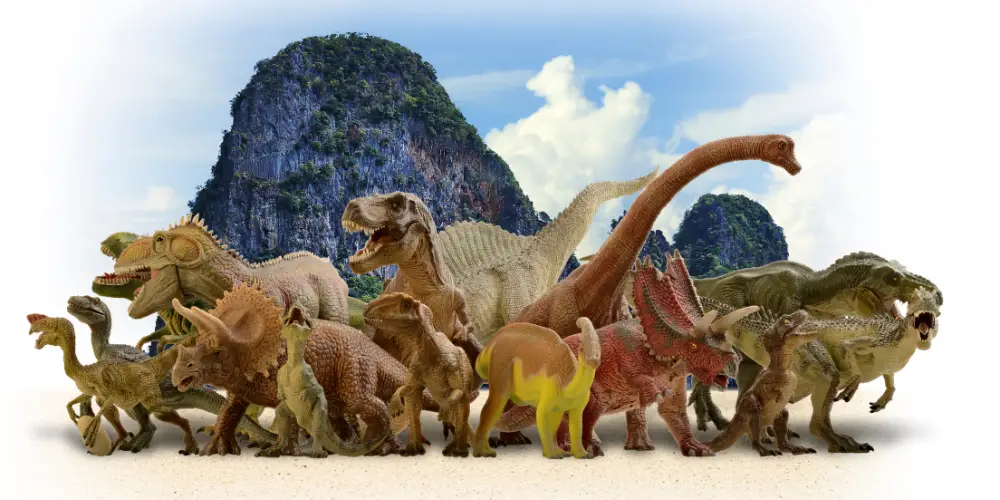Dinosaurs have always captivated the imagination of many, from children dreaming of colossal creatures to researchers studying Earth’s ancient inhabitants.
This exploration delves into the fascinating world of dinosaurs that start with D.
Prepare to be amazed by some of the most incredible creatures that once roamed our planet.
Top Dinosaurs That Start With ‘D’
Here is a list of dinosaurs that start with the letter D :
1. Deinonychus
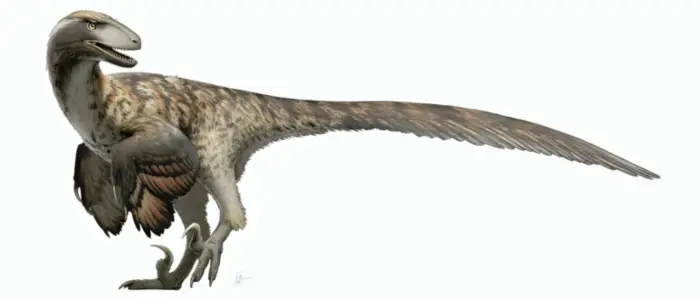
Description:
- Deinonychus was a dromaeosaurid theropod dinosaur that lived about 115–108 million years ago during the Early Cretaceous Period.
- It was a long-clawed carnivorous dinosaur that measured about 3.4 meters (11 feet) long, possibly larger.
- Fossils of Deinonychus have been found in the United States.
Characteristics:
- Deinonychus was bipedal, walking on two legs like all theropod dinosaurs.
- Its principal killing devices were large sickle-like talons 13 cm (5 inches) long on the second toe of each foot.
- Deinonychus had a slender, outstretched tail enclosed in bundles of bony rods.
Habitat:
- Geological evidence suggests that Deinonychus inhabited a floodplain or swamplike habitat.
- Deinonychus likely lived in forested areas and fed on small to medium-sized animals like reptiles and mammals.
- It lived in North America during the Early Cretaceous Period, and its fossils have been found in places such as Montana, Colorado, and Wyoming.
2. Dilophosaurus
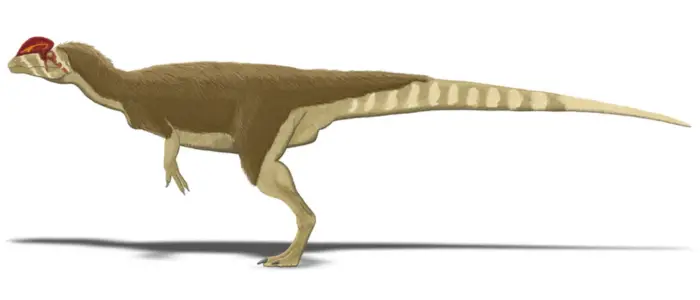
Description:
- Dilophosaurus was a genus of theropod dinosaur that lived during the Early Jurassic period, about 193-183 million years ago.
Characteristics:
- Dilophosaurus was a medium-sized theropod measuring about 6 meters (20 feet) in length. Its skull had distinctive crests, likely used for display or communication. It also had sharp teeth and claws, likely used for hunting small to medium-sized prey.
Habitat:
- Dilophosaurus likely lived in forested areas and fed on small to medium-sized animals like reptiles and mammals.
3. Diplodocus
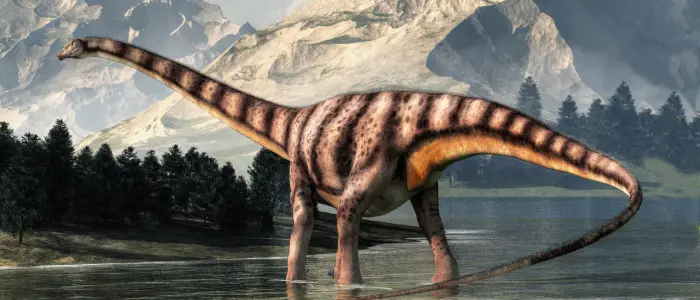
Description:
- Diplodocus was a genus of sauropod dinosaur that lived during the Late Jurassic period, about 154-152 million years ago.
Characteristics:
- Diplodocus was a massive dinosaur, measuring up to 27 meters (89 feet) in length. It had a long neck and tail, likely used for balance and communication. It also had a small head and peg-like teeth, likely used for cropping vegetation.
Habitat:
- Diplodocus likely lived in open habitats like plains and savannas, feeding on low-growing vegetation.
4. Dryosaurus
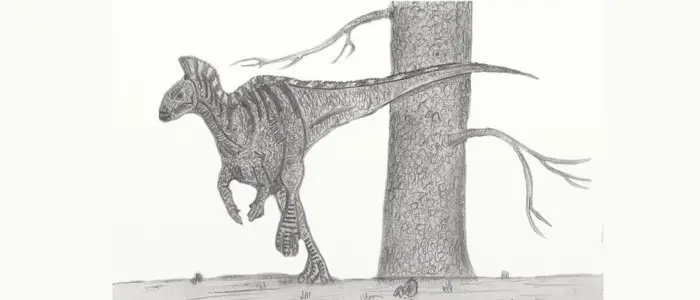
Description:
- Dryosaurus was a genus of ornithopod dinosaur that lived during the Late Jurassic period, about 155-145 million years ago.
- It was a bipedal dinosaur with a light build, long legs, long neck, and a stiff tail.
- Fossils of Dryosaurus have been found in North America.
Characteristics:
- Dryosaurus had a horny beak and cheek teeth, with a strong median ridge on the lateral surface.
- Its arms were short, with five fingers on each hand.
- Some scientists suggest that Dryosaurus had cheek-like structures to prevent food loss while the animal processed it in the mouth.
Habitat:
- Dryosaurus lived in a semi-arid environment with well-defined wet and dry seasons.
- It likely stayed in dense forest areas to feel comfortable.
- Dryosaurus subsisted primarily on low-growing vegetation in ancient floodplains.
- It was a quick and agile runner with strong legs, and used its stiff tail as a counterbalance.
5. Daspletosaurus
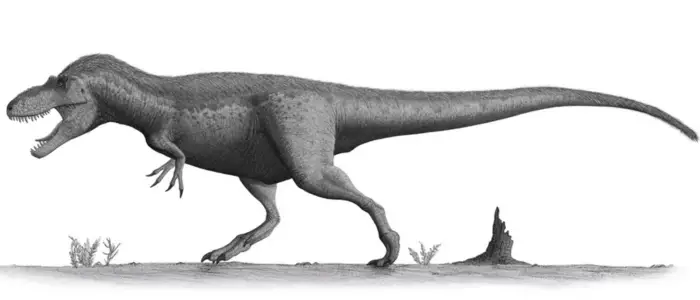
Description:
- Daspletosaurus is a tyrannosaurid dinosaur that lived in Laramidia about 77 and 75 million years ago, during the Late Cretaceous Period.
- Daspletosaurus contains three species: D. torosus, D. wilsoni, and D. horneri.
- Fossils of the earlier type species, D. torosus, have been found in Alberta, Canada, and fossils of the later two species have been found only in Montana, USA.
Characteristics:
- Daspletosaurus was a large carnivorous dinosaur, measuring up to 9 meters (30 feet) in length and weighing up to 2,200 kg (4,900 lbs).
- It had a large head with powerful jaws and sharp teeth, likely used for hunting and scavenging.
- Some specimens of Daspletosaurus show evidence of bite marks on their skulls, indicating that they may have engaged in intraspecific combat.
Habitat:
- Daspletosaurus lived in what is now western North America during the Late Cretaceous Period.
- It likely inhabited various environments, including forests, plains, and river valleys.
- Daspletosaurus was a top predator in its ecosystem, likely feeding on various prey, including other dinosaurs and small mammals.
6. Dracorex
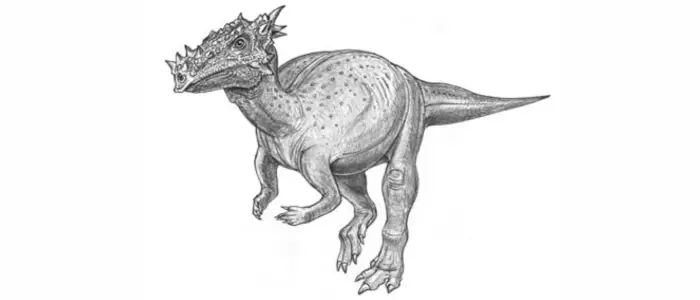
Description:
- Dracorex is a genus of pachycephalosaurid dinosaur that lived during the Late Cretaceous Period, about 66 million years ago. (image credits)
- Its name means “dragon king”, and its type species is Dracorex hogwartsia.
- Dracorex was identified after discovering a spectacular skull that lacks the dome characteristic of this group and instead has spikes and frills reminiscent of a mythical dragon.
- After studying the skull, scientists named the species Dracorex hogwartsia, the ‘dragon king of Hogwarts’, after the fictional Hogwarts School in the Harry Potter books by JK Rowling.
- Some scientists think the skull may actually belong to a young Pachycephalosaurus.
Characteristics:
- Dracorex was a small pachycephalosaurid dinosaur, measuring about 4 meters (13 feet) in length.
- It had a distinctive skull with spikes and frills, which were likely used for display or communication.
- Dracorex was likely herbivorous and lived during the Late Cretaceous Period, about 66 million years ago.
Habitat:
- Dracorex lived in what is now western North America during the Late Cretaceous Period.
- It likely inhabited a variety of environments, including forests, plains, and river valleys.
- Dracorex likely lived in small groups of around four individuals and preferred a less crowded exhibit.
- It was relatively unfussy with how much forest and grassland was in its habitat.
7. Deinocheirus
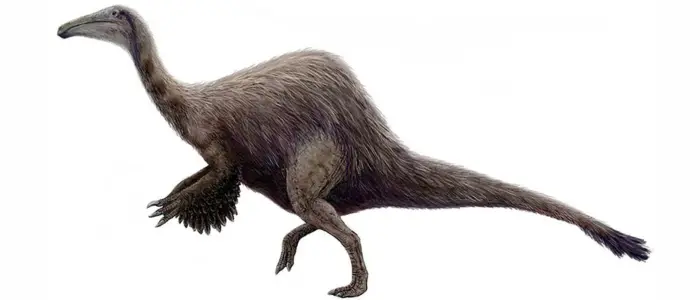
Description:
- Deinocheirus was a genus of ornithomimosaur dinosaur that lived about 70-66 million years ago during the Late Cretaceous period.
Characteristics:
- Deinocheirus was a large dinosaur, measuring up to 11 meters (36 feet) in length. It had a long neck and tail, likely used for balance and communication. It also had a distinctive pair of arms with large, curved claws, likely used for defense and gathering food.
Habitat:
- Deinocheirus likely lived in forested areas and fed on various foods, including plants and small animals.
8. Dromaeosaurus
Description:
- Dromaeosaurus was a genus of theropod dinosaur that lived about 76-72 million years ago during the Late Cretaceous period.
Characteristics:
- Dromaeosaurus was a medium-sized theropod, measuring about 2 meters (6.5 feet) in length. It had a distinctive sickle-shaped claw on each of its hind feet, likely used for hunting and defense. It also had sharp teeth and a powerful bite, likely used for hunting small to medium-sized prey.
Habitat:
- Dromaeosaurus likely lived in forested areas and fed on small to medium-sized animals like reptiles and mammals.
9. Dreadnoughtus
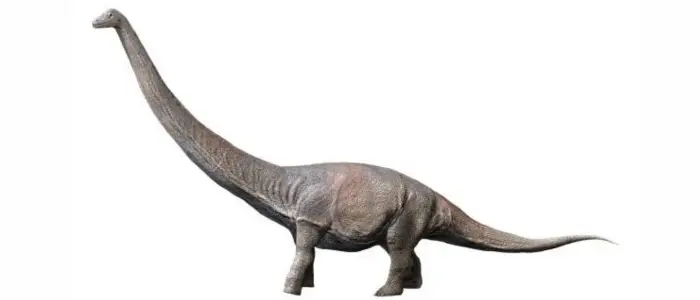
Description:
- Dreadnoughtus was a titanosaurian sauropod dinosaur that lived about 77-75 million years ago during the Late Cretaceous period.
Characteristics:
- Dreadnoughtus was a massive dinosaur, measuring up to 26 meters (85 feet) in length and weighing up to 59,300 kg (65 tons). It had a long neck and tail, likely used for balance and communication. It also had a small head and peg-like teeth, likely used for cropping vegetation.
Habitat:
- Dreadnoughtus likely lived in open habitats like plains and savannas, feeding on low-growing vegetation.
10. Dakotaraptor

Description:
- Dakotaraptor was a dromaeosaurid theropod dinosaur that lived about 66-100 million years ago during the Late Cretaceous period.
Characteristics:
- Dakotaraptor was a large dinosaur, measuring up to 5.5 meters (18 feet) in length. It had a distinctive sickle-shaped claw on each of its hind feet, likely used for hunting and defense. It also had sharp teeth and a powerful bite, likely used for hunting small to medium-sized prey.
Habitat:
- Dakotaraptor likely lived in forested areas and fed on small to medium-sized animals like reptiles and mammals.
Overall, these dinosaurs were fascinating and diverse creatures that played important roles in the ecosystems of their respective time periods.
Notable Discoveries and Locations
The vast world of paleontology has been enriched by the unearthing of ‘D’ dinosaurs over the years.
These discoveries have not only given us insight into the lives of these creatures but have also painted a more comprehensive picture of the prehistoric world.
- Daanosaurus: Primarily discovered in China, the remains of this dinosaur have shed light on the ecosystems of the Middle Jurassic period.
- Deinocheirus: Once a mystery due to only its massive arms being discovered, a nearly complete specimen found in Mongolia revealed this dinosaur as an odd-looking, large, ostrich-like creature. The find was a significant turning point, providing a clearer understanding of its biology and lifestyle.
- Dreadnoughtus: Found in Argentina, this colossal sauropod is one of the largest terrestrial creatures ever known. Excavating a relatively complete skeleton has helped researchers understand some dinosaurs’ sheer size and might.
- Dilophosaurus: Famously known for its portrayal in the movie “Jurassic Park”, real specimens of this dinosaur have been unearthed in the Kayenta Formation in Arizona. The findings contradicted the movie representation, as no evidence suggests they spit venom.
Museums and Locations: Many of the ‘D’ dinosaurs can be viewed in some of the world’s most renowned museums. The American Museum of Natural History in New York, the Field Museum in Chicago, and the Natural History Museum in London showcase some of these spectacular specimens. Visiting such places can offer an immersive experience, where one can witness the grandeur of these ancient creatures.
Recent excavations and research are ongoing, with many locations worldwide promising discoveries. Each find helps to unravel the mysteries of our planet’s vibrant and diverse past.
The Role of ‘D’ Dinosaurs in Popular Culture
Dinosaurs, in general, have left an indelible mark on popular culture, captivating audiences of all ages for generations.
The ‘D’ dinosaurs, in particular, have had their moments in the limelight, weaving their way into various aspects of media and entertainment.
- Movies:
- Dilophosaurus: Arguably one of the most famous ‘D’ dinosaurs due to its memorable appearance in “Jurassic Park”. Though the movie depicted it with a frill and as spitting venom, these traits are purely fictional.
- Dreadnoughtus: Featured in several documentaries, this colossal sauropod is often used to showcase the immense size some dinosaurs could reach.
- Books:
- Numerous children’s books have illustrated encyclopedias that feature dinosaurs starting with ‘D’, helping educate and fascinate the younger generation.
- Science fiction novels and stories occasionally introduce these dinosaurs to explore speculation and alternate histories.
- TV Shows:
- Various ‘D’ dinosaurs, like the Dakotaraptor and Deinocheirus, have been showcased in paleontology-based TV series such as “Walking with Dinosaurs” and “Planet Dinosaur”. These shows aim to recreate these magnificent creatures’ habitats, behaviors, and lives.
- Toys and Merchandise:
- Dinosaurs are a staple in toy industries. ‘D’ dinosaurs like Diplodocus, Diceratops, and Dracorex can be found in action figure forms, plush toys, and even LEGO sets.
- Dunkleosteus, despite being a prehistoric fish, has also made its way into toy stores, intriguing kids with its fierce appearance.
- Video Games:
- Dinosaurs starting with ‘D’ have also appeared in video games. Whether players are tasked to hunt, tame, or even evolve these creatures, games like “ARK: Survival Evolved” and “Jurassic World Evolution” offer interactive experiences with these prehistoric giants.
Cultural Influence: Beyond entertainment, these dinosaurs have influenced art, fashion, and even language. Phrases like “Dino-sized” often allude to the enormous sizes of creatures like the Dreadnoughtus. D’ dinosaurs’ unique forms and features have inspired murals, clothing designs, and tattoos.
‘D’ dinosaurs, like all dinosaurs, are a testament to the human fascination with creatures from our planet’s distant past. They invoke wonder, curiosity, and a deep appreciation of life on Earth.
Modern Research and Findings on ‘D’ Dinosaurs
As technology and scientific methodologies advance, our understanding of dinosaurs continues to evolve, offering fresh perspectives and findings on these magnificent creatures.
This is especially true for ‘D’ dinosaurs, where ongoing research has led to significant revelations:
- Dilophosaurus:
- Recent findings suggest that the Dilophosaurus, once considered a smaller dinosaur, was much larger and more formidable than earlier reconstructions had indicated. High-resolution CT scans of fossils also debunked the idea that it had a movable crest.
- Deinocheirus:
- Once a mystery due to its bizarre, large arms with giant claws, the discovery of more complete fossils in Mongolia unveiled that Deinocheirus was an odd-looking, humpbacked omnivorous theropod. This breakthrough corrected many misconceptions about its ecology and behavior.
- Dreadnoughtus:
- Using laser-scanning technology, scientists got a more accurate estimate of this sauropod’s weight, making it one of the heaviest creatures ever to walk the earth. Additionally, bone histology has given insights into its growth patterns and life history.
- Dakotaraptor:
- Fossilized soft tissues and feathers indicate that this raptor had plumage, reinforcing the link between birds and theropod dinosaurs. This discovery has also helped clarify the role of feathers in non-avian dinosaurs.
- Technological Advancements in Paleontology:
- Tools like synchrotron scanning have allowed scientists to analyze fossils at the cellular level. This has been particularly useful in studying dinosaur eggs and embryonic development.
- Digital modeling and simulation enable researchers to study dinosaur biomechanics in unimaginable ways. This has been beneficial for understanding the movement and behavior of many ‘D’ dinosaurs.
- Climate and Environmental Studies:
- By examining isotopes in fossilized teeth and bones, researchers can gather data about these dinosaurs’ ancient habitats and diets. For instance, data from Dromaeosaurus remains have provided clues about the Cretaceous climate.
- Reclassification and Phylogeny:
- As new fossils emerge and molecular techniques evolve, some ‘D’ dinosaurs have been reclassified. Phylogenetic trees are continuously refined, reflecting a deeper understanding of the relationships between species.
Modern research is reshaping our understanding of ‘D’ dinosaurs, uncovering fascinating details about their anatomy, behavior, and ecology.
These discoveries underscore the importance of continued research and the need to preserve fossils for future studies.
Final Thoughts

The world of dinosaurs is vast, intriguing, and holds mysteries that have captivated humanity for generations.
Among this incredible variety, the ‘D’ dinosaurs stand out for their unique attributes, significant contributions to our understanding of prehistoric life, and diverse roles in their times’ ecosystems.
From the enormous Dreadnoughtus, representing one of the heaviest creatures ever to roam the earth, to the agile and fearsome Dakotaraptor with evidence of plumage, these dinosaurs offer a microcosm of the prehistoric world’s vast diversity.
The unique characteristics of each of these creatures help paint a clearer picture of life millions of years ago, filling in knowledge gaps and constantly reshaping our understanding of natural history.
Moreover, the ‘D’ dinosaurs’ influence isn’t limited to the scientific community. Their appearances in popular culture—movies, books, TV shows, and toys—demonstrate their lasting impact on our imagination and creativity.
These depictions, while sometimes not entirely accurate, underline the importance of continued paleontological research to correct misconceptions and offer more precise portrayals in the future.
The journey into the world of ‘D’ dinosaurs isn’t merely an academic pursuit; it’s a gateway to igniting curiosity, fostering a love for science, and appreciating the intricate tapestry of life on our planet.
In closing, while we’ve delved deep into the world of ‘D’ dinosaurs, this is but a fragment of the incredible universe of dinosaurs.
We invite readers to continue this journey, explore other fascinating species, and remain ever-curious about the wonders of our natural world.
REFERENCES:
- List of dinosaur genera. (2023, September 7). In Wikipedia. https://en.wikipedia.org/wiki/List_of_dinosaur_genera
- Natural History Museum. Dino Directory Name A-Z – Dinosaurs beginning with the letter D. Retrieved from https://www.nhm.ac.uk/discover/dino-directory/name/d/gallery.html


